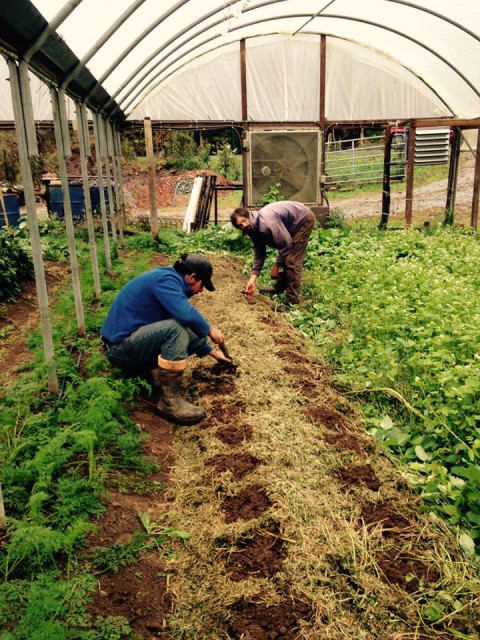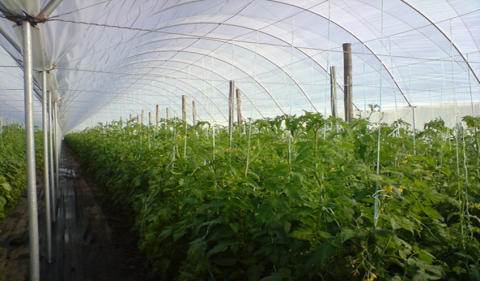The long summer is behind us, but for many growers in Western North Carolina, the spring-summer growing season is only half the story. Commercial growers, donation gardens and garden-based education programs are all finding ways to keep local foods and food security growing in WNC, year-round.
Securing the harvest
WNC is populated by many gardens that grow for donation. Garden networks such as Bountiful Cities and Gardens That Give help to connect community gardens with food pantries or neighbors experiencing food insecurity. But what happens when the growing season ends?
“Generally at this latitude, we do not have sufficient hours of sunlight between Dec. 10 and Jan. 10 to [grow] anything,” says Buzz Durham, garden manager at the Grace Covenant Community Garden.
But that doesn’t keep local community gardens from erecting simple structures to extend their growing seasons. At Grace Covenant, Durham says the church’s youth group has worked with the garden volunteers to build a winter grow chamber constructed from raised beds covered with thermoplastic sheets that will allow broccoli, cabbage and cauliflower to grow into November and kale, collards and turnips to grow until the temperature reaches -20 degrees.
“The kids gained this understanding of food insecurity from studying Guatemala and Haiti through the church,” Durham says. “But they realized on their own that food insecurity is something happening in Asheville too. They picked up on that need and wanted to do something.”
Living Web Farms, a member of the Gardens That Give network, will be able to continue its food donation program throughout the year thanks to two on-site greenhouses.
“Our farm was founded on a mission of creating systems that are sustainable — all the time,” says Meredith Leigh, education and community outreach coordinator. “So the farm was designed to be able to grow and to donate food year-round.”
Living Web donates produce to 12 different pantries in WNC, Leigh says, with cabbage, cauliflower, kale, turnips, radishes and bok choy growing for most of the year. She adds that the farm steers clear of “gourmet vegetables” — focusing on foods that are nutrient-rich but that people are familiar with and will know how to prepare.
Leigh says Living Web expects to be able to grow more food for donation this year by increasing production in the greenhouses. She adds that homesteaders or growers looking to combat food insecurity on a neighborhood level can extend their season through simple hoop houses and cold frames, which can be constructed with materials available at local gardening centers.
“When we talk about resiliency, we need to realize that a large part of that is developing systems that support people,” Leigh says. “The pantries we work with are always so grateful — there’s such a gap to fill.”
Putting the pieces together
Alan Rose’s life was very different five years ago. Working for an Atlanta-based company tasked with reducing health care costs for clients such as Disney and Nordstrom, Rose says his life was centered around “frequent flier miles” and “Atlanta traffic.” It’s a far cry from his life now — living in Black Mountain, a few blocks away from the organic farm he and his family own.
It was Rose’s son Andrew who introduced his parents to ideas like organic vegetables and the importance of a local food economy— coming home from Vanderbilt (where he was president of the campus’ farming initiative) and encouraging his parents to eat healthy foods and read Michael Pollan. “I remember my wife reading Botany of Desire and going, “Oh my god, this is amazing,” Rose laughs.
After visiting Western North Carolina for Appalachian Sustainable Agriculture Project’s 2011 Farm Tour, the Roses decide to start New Sprout Organic Farms. That’s right — farms, with an “s.” Because from the beginning, Rose says, he knew New Sprout wouldn’t just be one place — it would be a network of small farms working together under one umbrella.
“What we realized early on is that it’s really hard to do all the steps — from deciding what to grow, to growing it and harvesting it, then packing and storing, post-harvest handling, the accounts receivable, the accounts payable, the regulations in terms of certification,” Rose says. “We knew there were a lot of folks who are extremely passionate and capable of growing, but who cannot easily or affordably cover the rest of it. So basically we said, ‘If you can grow good-quality, organic produce, then we can do everything else.’”
So the Roses and their crew set out to make New Sprout a network, which by the end of this year will include 15 organic farms with sites in eastern North Carolina, Alabama and Georgia and some sites in Florida joining next year. The farmers in the network grow their crops in an exclusive contract with New Sprout in exchange for the use of transportation, storage facilities and equipment.
“It’s not that we’re growing ‘off-site,’” Andrew Rose says. “There are other companies that go and buy produce from different regions and just sell it under the same branding, but what we want to do is support other small farmers who grow quality organic produce by making them an equal part of New Sprout Farms.”
What the network also does is extend New Sprout’s growing season throughout the year — with growers in the southernmost states still able to harvest crops in January and February. As an independent business, Andrew says it was crucial for New Sprout to overcome the classic farming dilemma — 12 months of expenses without 12 months of harvest. And the growing network, Alan adds, ensures that the storage facility in Black Mountain with its industrial coolers and forklift, isn’t just sitting there unused.
Andrew says several of the farms will also use high tunnel structures to extend their growing season this year. The simple structures — made from PVC pipes covered with plastic sheets — can be used to canopy as much as three-quarters of an acre, heating crops by trapping solar energy, ambient heat from the earth or heat generated by composting under the plastic hood. It allows New Sprout to extend the season for cucumbers, tomatoes and peppers, and makes it possible for some of the sites to grow bok choy and arugula in the dead of winter.
“I think high tunnels have a chance to have an amazing impact on the Southeast foodshed,” Andrew says. “Just being able to produce more food, and more nutrient-dense food — I mean, that’s why we got into this in the first place.”
Year-round education

Hall Fletcher Elementary School is oddly quiet during the first week of October. The kids are enjoying their fall break, but teachers like garden instructor Rachel Lubitz are busy preparing lesson plans for when the students return.
This summer, Hall Fletcher switched to a year-round academic schedule of 9-weeks on and 3-weeks off — meaning Lubitz will also be leading year-round gardening courses to supplement each grade level’s state-mandated science curriculum.
“It has this great advantage of giving them an understanding of the transition from season to season and what grows in the garden at which time,” Lubitz says. “It also allows us to have variety of edibles, flowers and herbs that they can cook with and explore — so they can investigate the various parts of the plant but also be able to eat things in the gardening program throughout the winter.”
The program utilizes a small greenhouse built in 2001 with funds from a Lowe’s Toollbox for Education grant. Starting in March, the kids will participate in farm fields trips and the Muddy Sneakers outdoor program, but during the winter months the greenhouse will be the kids only outdoor-based learning program, Lubitz says.
“So for example, the fourth graders study what is beneficial for an ecosystem versus what is harmful,” she explains. “We use the greenhouse for experiments where you water one plant with water and another with soda, or plant one in compost and another without compost. It allows them to understand what is beneficial for the plant and also see how human impact can be harmful.”
In the coldest months, Lubitz says the program will focus on cooking demonstrations and incorporating edibles from the greenhouse into recipes and experiments. If funding allows, the school hopes to complete a cob oven for the spring so that, once the harvest starts, community members can grow, pick and even prepare food at Hall Fletcher — a farm-to-table experience within a school.
“I do think about it as a farm-to-table thing, but there are also so many other components: nutrition, environmental stewardship, organic gardening, experimental learning, science,” Lubitz says. “The farm-to-table aspect is just icing on the cake.”






Before you comment
The comments section is here to provide a platform for civil dialogue on the issues we face together as a local community. Xpress is committed to offering this platform for all voices, but when the tone of the discussion gets nasty or strays off topic, we believe many people choose not to participate. Xpress editors are determined to moderate comments to ensure a constructive interchange is maintained. All comments judged not to be in keeping with the spirit of civil discourse will be removed and repeat violators will be banned. See here for our terms of service. Thank you for being part of this effort to promote respectful discussion.